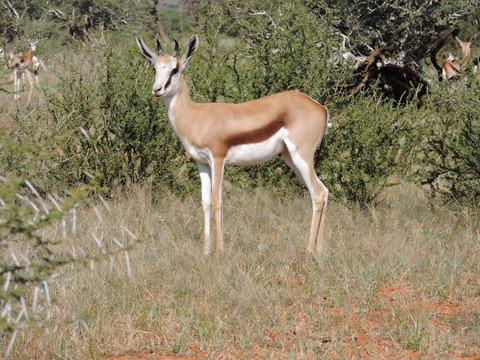Our official English website, www.x-mol.net, welcomes your
feedback! (Note: you will need to create a separate account there.)
Carbon isotope differences between grassland and savanna herbivores reveal environmentally driven rather than phylogenetically conserved niches
Journal of Zoology ( IF 1.9 ) Pub Date : 2020-01-26 , DOI: 10.1111/jzo.12762 S. Malindie 1 , F.T. Buschke 1 , D. Codron 2
Journal of Zoology ( IF 1.9 ) Pub Date : 2020-01-26 , DOI: 10.1111/jzo.12762 S. Malindie 1 , F.T. Buschke 1 , D. Codron 2
Affiliation

|
Stable isotope analyses provide insights into large herbivore diets. Carbon isotopes are particularly useful for analysing diet given their ability to reflect C3 or C4 photosynthetic pathways and, therefore, distinguish between browser and grazer diets. Although isotopes are useful for comparing diets across a range of spatial and temporal scales, most studies have focused on either interspecific differences within habitats or single species averages across their geographic range. In this study, we use both new and existing carbon isotopic data to compare large mammal herbivore diets across habitat types in southern and east Africa. We examined whether species in the grassland biome of central South Africa had the same carbon isotopic signatures as counterparts from savannas in southern and east Africa. Within the grassland biome, isotopic signatures from faecal samples were strongly correlated with signatures from bone and dentine collagen samples, supporting our approach of comparing faecal data from the grasslands with savanna data obtained mainly through analysis of skeletal materials. Regression analysis comparing grasslands and savannas confirmed that species' isotopic niches within communities were conserved across different geographic regions. However, herbivore δ13C values were generally lower in the grassland compared with the savanna biome, highlighted particularly by the lower δ13C values of several grazer species (but not browsers), indicating greater consumption of C3 vegetation in grasslands. This finding is counter‐intuitive and suggests that non‐woody C3 vegetation may be an important component of grazer diets in the grassland biome. We speculate on various environmental factors, related to food abundance that could underline the pattern.
中文翻译:

草原和热带稀树草原食草动物之间的碳同位素差异揭示了环境驱动而非系统发育保守的生态位
稳定的同位素分析为大型食草动物饮食提供了见识。由于碳同位素能够反映C 3或C 4,因此对于分析饮食特别有用光合途径,因此区分浏览器饮食和放牧者饮食。尽管同位素可用于比较各种时空尺度上的饮食,但是大多数研究都集中在生境之间的种间差异或地理范围内的单个物种平均值上。在这项研究中,我们使用新的和现有的碳同位素数据来比较南部和东部非洲不同生境类型的大型哺乳动物草食动物饮食。我们检查了南非中部草原生物群落中的物种是否具有与南部和东部非洲大草原的对应物种相同的碳同位素特征。在草原生物群落中,粪便样品的同位素特征与骨骼和牙本质胶原蛋白样品的特征密切相关,支持我们将草原粪便数据与主要通过骨骼材料分析获得的稀树草原数据进行比较的方法。比较草原和热带稀树草原的回归分析证实,社区内物种的同位素生态位在不同地理区域内均得到保护。然而,草食动物δ13个C值一般都降低在草原与稀树草原生物群落相比,强调尤其由下部δ 13几个食草动物物种(但不是浏览器)的C值,定义了C的消耗更大3在草原植被。这一发现是违反直觉的,表明非木本的C 3植被可能是草原生物群落中食草动物饮食的重要组成部分。我们推测了与食物丰度有关的各种环境因素,这些因素可能突显了这种模式。
更新日期:2020-01-26
中文翻译:

草原和热带稀树草原食草动物之间的碳同位素差异揭示了环境驱动而非系统发育保守的生态位
稳定的同位素分析为大型食草动物饮食提供了见识。由于碳同位素能够反映C 3或C 4,因此对于分析饮食特别有用光合途径,因此区分浏览器饮食和放牧者饮食。尽管同位素可用于比较各种时空尺度上的饮食,但是大多数研究都集中在生境之间的种间差异或地理范围内的单个物种平均值上。在这项研究中,我们使用新的和现有的碳同位素数据来比较南部和东部非洲不同生境类型的大型哺乳动物草食动物饮食。我们检查了南非中部草原生物群落中的物种是否具有与南部和东部非洲大草原的对应物种相同的碳同位素特征。在草原生物群落中,粪便样品的同位素特征与骨骼和牙本质胶原蛋白样品的特征密切相关,支持我们将草原粪便数据与主要通过骨骼材料分析获得的稀树草原数据进行比较的方法。比较草原和热带稀树草原的回归分析证实,社区内物种的同位素生态位在不同地理区域内均得到保护。然而,草食动物δ13个C值一般都降低在草原与稀树草原生物群落相比,强调尤其由下部δ 13几个食草动物物种(但不是浏览器)的C值,定义了C的消耗更大3在草原植被。这一发现是违反直觉的,表明非木本的C 3植被可能是草原生物群落中食草动物饮食的重要组成部分。我们推测了与食物丰度有关的各种环境因素,这些因素可能突显了这种模式。











































 京公网安备 11010802027423号
京公网安备 11010802027423号